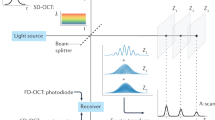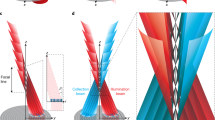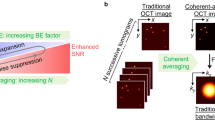Abstract
Optical coherence tomography (OCT) is a cross-sectional, micrometre-scale imaging modality with widespread clinical application. Typical OCT systems sacrifice lateral resolution to achieve long depths of focus for bulk tissue imaging, and therefore tend to have better axial than lateral resolution. Such anisotropic resolution can obscure fine ultrastructural features. Furthermore, conventional OCT suffers from refraction-induced image distortions. Here, we introduce optical coherence refraction tomography (OCRT), which extends the superior axial resolution to the lateral dimension, synthesizing undistorted cross-sectional image reconstructions from multiple conventional images acquired with angular diversity. In correcting refraction-induced distortions to register the OCT images, OCRT also achieves spatially resolved refractive index imaging. We demonstrate greater than threefold improvement in lateral resolution as well as speckle reduction in imaging the tissue ultrastructure, consistent with histology. With further optimization in optical designs to incorporate angular diversity into clinical instruments, OCRT could be widely applied as an enhancement over conventional OCT.
This is a preview of subscription content, access via your institution
Access options
Access Nature and 54 other Nature Portfolio journals
Get Nature+, our best-value online-access subscription
$29.99 / 30 days
cancel any time
Subscribe to this journal
Receive 12 print issues and online access
$209.00 per year
only $17.42 per issue
Buy this article
- Purchase on Springer Link
- Instant access to full article PDF
Prices may be subject to local taxes which are calculated during checkout






Similar content being viewed by others
Data availability
The multi-angle datasets for the biological samples in Figs. 4–6 are available at https://doi.org/10.6084/m9.figshare.8297138.
Code availability
The Python code used for generating the OCRT results in Figs. 4–6 is available at https://github.com/kevinczhou/optical-coherence-refraction-tomography.
References
Huang, D. et al. Optical coherence tomography. Science 254, 1178–1181 (1991).
Povazay, B. et al. Submicrometer axial resolution optical coherence tomography. Opt. Lett. 27, 1800–1802 (2002).
Izatt, J. A. & Choma, M. A. in Optical Coherence Tomography: Technology and Applications (eds Drexler, W. & Fujimoto, J. G.) 47–72 (Springer, 2008).
Ralston, T. S., Marks, D. L., Carney, P. S. & Boppart, S. A. Interferometric synthetic aperture microscopy. Nat. Phys. 3, 129–134 (2007).
Bo, E. et al. Depth-of-focus extension in optical coherence tomography via multiple aperture synthesis. Optica 4, 701–706 (2017).
Blatter, C. et al. Extended focus high-speed swept source OCT with self-reconstructive illumination. Opt. Express 19, 12141–12155 (2011).
Lee, K.-S. & Rolland, J. P. Bessel beam spectral-domain high-resolution optical coherence tomography with micro-optic axicon providing extended focusing range. Opt. Lett. 33, 1696–1698 (2008).
Liu, L. et al. Imaging the subcellular structure of human coronary atherosclerosis using micro–optical coherence tomography. Nat. Med. 17, 1010 (2011).
Lorenser, D., Yang, X. & Sampson, D. D. Ultrathin fiber probes with extended depth of focus for optical coherence tomography. Opt. Lett. 37, 1616–1618 (2012).
Mo, J., de Groot, M. & de Boer, J. F. Focus-extension by depth-encoded synthetic aperture in optical coherence tomography. Opt. Express 21, 10048–10061 (2013).
Ding, Z., Ren, H., Zhao, Y., Nelson, J. S. & Chen, Z. High-resolution optical coherence tomography over a large depth range with an axicon lens. Opt. Lett. 27, 243–245 (2002).
Leitgeb, R. A., Villiger, M., Bachmann, A. H., Steinmann, L. & Lasser, T. Extended focus depth for Fourier domain optical coherence microscopy. Opt. Lett. 31, 2450–2452 (2006).
Coquoz, S., Bouwens, A., Marchand, P. J., Extermann, J. & Lasser, T. Interferometric synthetic aperture microscopy for extended focus optical coherence microscopy. Opt. Express 25, 30807–30819 (2017).
Pircher, M., Götzinger, E. & Hitzenberger, C. K. Dynamic focus in optical coherence tomography for retinal imaging. J. Biomed. Opt. 11, 054013 (2006).
Huber, R., Wojtkowski, M., Fujimoto, J. G., Jiang, J. Y. & Cable, A. E. Three-dimensional and C-mode OCT imaging with a compact, frequency swept laser source at 1,300 nm. Opt. Express 13, 10523–10538 (2005).
Qi, B. et al. Dynamic focus control in high-speed optical coherence tomography based on a microelectromechanical mirror. Opt. Commun. 232, 123–128 (2004).
Podoleanu, A., Charalambous, I., Plesea, L., Dogariu, A. & Rosen, R. Correction of distortions in optical coherence tomography imaging of the eye. Phys. Med. Biol. 49, 1277 (2004).
Ortiz, S. et al. Optical distortion correction in optical coherence tomography for quantitative ocular anterior segment by three-dimensional imaging. Opt. Express 18, 2782–2796 (2010).
Westphal, V., Rollins, A. M., Radhakrishnan, S. & Izatt, J. A. Correction of geometric and refractive image distortions in optical coherence tomography applying Fermat’s principle. Opt. Express 10, 397–404 (2002).
Willi, A. K. X-ray computed tomography. Phys. Med. Biol. 51, R29 (2006).
Takahiro, K. & Takanori, N. Refractive index tomography based on optical coherence tomography and tomographic reconstruction algorithm. Jpn J. Appl. Phys. 56, 09NB03 (2017).
Zysk, A. M., Reynolds, J. J., Marks, D. L., Carney, P. S. & Boppart, S. A. Projected index computed tomography. Opt. Lett. 28, 701–703 (2003).
Wang, Y. & Wang, R. K. High-resolution computed tomography of refractive index distribution by transillumination low-coherence interferometry. Opt. Lett. 35, 91–93 (2010).
Binding, J. et al. Brain refractive index measured in vivo with high-NA defocus-corrected full-field OCT and consequences for two-photon microscopy. Opt. Express 19, 4833–4847 (2011).
Tearney, G. J. et al. Determination of the refractive index of highly scattering human tissue by optical coherence tomography. Opt. Lett. 20, 2258–2260 (1995).
Knuttel, A. & Boehlau-Godau, M. Spatially confined and temporally resolved refractive index and scattering evaluation in human skin performed with optical coherence tomography. J. Biomed. Opt. 5, 83–92 (2000).
Zvyagin, A. V. et al. Refractive index tomography of turbid media by bifocal optical coherence refractometry. Opt. Express 11, 3503–3517 (2003).
Hsieh, J. in Computed Tomography: Principles, Design, Artifacts, and Recent Advances Ch. 3 (SPIE, 2015).
Shepp, L. A. & Logan, B. F. The Fourier reconstruction of a head section. IEEE Trans. Nucl. Sci. 21, 21–43 (1974).
Saleh, B. E. A. & Teich, M. C. in Fundamentals of Photonics Ch. 1 (Wiley-Interscience, 2007).
Nadaraya, E. On estimating regression. Theory Probab. Appl. 9, 141–142 (1964).
Dormand, J. R. & Prince, P. J. A family of embedded Runge–Kutta formulae. J. Comput. Appl. Math. 6, 19–26 (1980).
Kingma, D. P. & Ba, J. Adam: a method for stochastic optimization. Preprint at https://arxiv.org/abs/1412.6980 (2014).
Abadi, M. et al. TensorFlow: large-scale machine learning on heterogeneous distributed systems. Preprint at https://arxiv.org/abs/1603.04467 (2016).
Uhlhorn, S. R., Manns, F., Tahi, H., Rol, P. O. & Parel, J.-M. A. Corneal group refractive index measurement using low-coherence interferometry. In BiOS ‘98 International Biomedical Optics Symposium Vol. 3246, 14–21 (SPIE, 1998).
Hitzenberger, C. K. Optical measurement of the axial eye length by laser doppler interferometry. Invest. Ophthalmol. Vis. Sci. 32, 616–624 (1991).
Young, L. K., Joseph, T. W.Jr, Thomas, K. G. & Matthew, R. G. Variation of corneal refractive index with hydration. Phys. Med. Biol. 49, 859–868 (2004).
Sharpe, J. Optical projection tomography. Annu. Rev. Biomed. Eng. 6, 209–228 (2004).
Wu, C. et al. Comparison and combination of rotational imaging optical coherence tomography and selective plane illumination microscopy for embryonic study. Biomed. Opt. Express 8, 4629–4639 (2017).
Fuchs, S. et al. Optical coherence tomography with nanoscale axial resolution using a laser-driven high-harmonic source. Optica 4, 903–906 (2017).
Wang, H. & Rollins, A. M. Speckle reduction in optical coherence tomography using angular compounding by B-scan Doppler-shift encoding. J. Biomed. Opt. 14, 030512 (2009).
Desjardins, A. E., Vakoc, B. J., Tearney, G. J. & Bouma, B. E. Speckle reduction in OCT using massively-parallel detection and frequency-domain ranging. Opt. Express 14, 4736–4745 (2006).
Iftimia, N., Bouma, B. E. & Tearney, G. J. Speckle reduction in optical coherence tomography by ‘path length encoded’ angular compounding. J. Biomed. Opt. 8, 260–263 (2003).
Yao, J., Meemon, P., Ponting, M. & Rolland, J. P. Angular scan optical coherence tomography imaging and metrology of spherical gradient refractive index preforms. Opt. Express 23, 6428–6443 (2015).
Carrasco-Zevallos, O. et al. Pupil tracking optical coherence tomography for precise control of pupil entry position. Biomed. Opt. Express 6, 3405–3419 (2015).
Tam, K. C. & Perez-Mendez, V. Tomographical imaging with limited-angle input. J. Opt. Soc. Am. 71, 582–592 (1981).
Klein, T. & Huber, R. High-speed OCT light sources and systems [Invited]. Biomed. Opt. Express 8, 828–859 (2017).
Fang, L., Li, S., Cunefare, D. & Farsiu, S. Segmentation based sparse reconstruction of optical coherence tomography images. IEEE Trans. Med. Imaging 36, 407–421 (2017).
Kaganovsky, Y. et al. Compressed sampling strategies for tomography. J. Opt. Soc. Am. A 31, 1369–1394 (2014).
Horstmeyer, R., Chung, J., Ou, X., Zheng, G. & Yang, C. Diffraction tomography with Fourier ptychography. Optica 3, 827–835 (2016).
Chowdhury, S., Eldridge, W. J., Wax, A. & Izatt, J. Refractive index tomography with structured illumination. Optica 4, 537–545 (2017).
Lim, J. et al. Comparative study of iterative reconstruction algorithms for missing cone problems in optical diffraction tomography. Opt. Express 23, 16933–16948 (2015).
Fiolka, R., Wicker, K., Heintzmann, R. & Stemmer, A. Simplified approach to diffraction tomography in optical microscopy. Opt. Express 17, 12407–12417 (2009).
Sung, Y. et al. Optical diffraction tomography for high resolution live cell imaging. Opt. Express 17, 266–277 (2009).
Guizar-Sicairos, M., Thurman, S. T. & Fienup, J. R. Efficient subpixel image registration algorithms. Opt. Lett. 33, 156–158 (2008).
Acknowledgements
We thank G. Waterman for designing the rotation stage, M. Stern for helpful advice regarding TensorFlow, A. Kuo for providing the human cornea samples and M. Fitzmaurice for helpful discussions regarding the biological data. K.C.Z. was supported by the National Science Foundation (DGF-1106401), J.A.I. was supported in part by the National Institutes of Health (U01EY028079) and S.F. was supported in part by the National Institutes of Health (P30EY005722) and the Google Faculty Research Award.
Author information
Authors and Affiliations
Contributions
K.C.Z. and J.A.I. conceived and developed the idea. R.Q. and S.F. helped to further develop the idea. K.C.Z. developed the algorithms, wrote the code, and collected and analysed the data. R.Q. assisted with data collection and performed the Zemax simulations. All authors contributed to data interpretation. S.D. prepared all biological samples for data collection and histology.
Corresponding author
Ethics declarations
Competing interests
K.C.Z., R.Q., S.F. and J.A.I. have submitted a patent application for this work, assigned to Duke University. J.A.I. is also an inventor on multiple patents, including those licensed to Leica Microsystems and Carl Zeiss Meditec.
Additional information
Publisher’s note: Springer Nature remains neutral with regard to jurisdictional claims in published maps and institutional affiliations.
Supplementary information
Supplementary Information
This file contains more information about the work and Supplementary Figs. 1–12.
Rights and permissions
About this article
Cite this article
Zhou, K.C., Qian, R., Degan, S. et al. Optical coherence refraction tomography. Nat. Photonics 13, 794–802 (2019). https://doi.org/10.1038/s41566-019-0508-1
Received:
Accepted:
Published:
Issue Date:
DOI: https://doi.org/10.1038/s41566-019-0508-1
This article is cited by
-
Visualization of CO2 electrolysis using optical coherence tomography
Nature Chemistry (2024)
-
Ultrasound-induced reorientation for multi-angle optical coherence tomography
Nature Communications (2024)
-
In-silico clearing approach for deep refractive index tomography by partial reconstruction and wave-backpropagation
Light: Science & Applications (2023)
-
On the inverse problem in optical coherence tomography
Scientific Reports (2023)
-
Metasurface-based bijective illumination collection imaging provides high-resolution tomography in three dimensions
Nature Photonics (2022)



